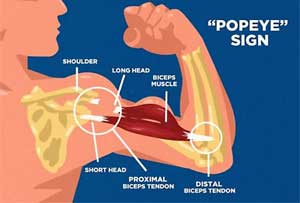- Home
- Editorial
- News
- Practice Guidelines
- Anesthesiology Guidelines
- Cancer Guidelines
- Cardiac Sciences Guidelines
- Critical Care Guidelines
- Dentistry Guidelines
- Dermatology Guidelines
- Diabetes and Endo Guidelines
- Diagnostics Guidelines
- ENT Guidelines
- Featured Practice Guidelines
- Gastroenterology Guidelines
- Geriatrics Guidelines
- Medicine Guidelines
- Nephrology Guidelines
- Neurosciences Guidelines
- Obs and Gynae Guidelines
- Ophthalmology Guidelines
- Orthopaedics Guidelines
- Paediatrics Guidelines
- Psychiatry Guidelines
- Pulmonology Guidelines
- Radiology Guidelines
- Surgery Guidelines
- Urology Guidelines
A case presenting with "Popeye” Sign

The long head of the biceps may rupture near to its scapular origin in older patients, over the age of 50 years, following quite minimal trauma.Usually, the patient reports that he heard something "snap" on the shoulder whilst lifting. Often, the shoulder aches and the upper arm is bruised. Characteristically, flexion of the arm at the elbow produces a firm lump in the lower part of the arm - this is the unopposed contracted muscle belly of the biceps.The long head of biceps may rupture due to sudden loading (which may be painful and associated with an audible pop) or may occur asymptomatically and painlessly.
The examination of patient may reveal bruising over the proximal anterior arm and there may be an obvious swelling in the arm caused by the contracted biceps muscle ('Popeye sign') which does not move with supination
In the instant case, sent by Dr. Naoki Yoshida and associates, a 79-year-old man presented to the orthopedic clinic with a large bulge on his left upper arm. The bulge had developed 2 days before presentation when he was lifting an object and felt a sudden sharp pain in his left shoulder.The case has been published in The New England Journal of Medicine.
A physical examination revealed an obvious deformity in the anterior mid-upper arm that became more pronounced during elbow flexion. biceps tendon. MRI of the shoulder revealed a complete rupture of the long head of the biceps tendon. Known as the “Popeye” sign or Popeye deformity, this finding on physical examination is caused by bulging of the biceps muscle belly after rupture of the biceps tendon; however, patients with a rupture of this tendon do not always present with the Popeye sign.
Rupture of the biceps tendon usually occurs proximally and often occurs in older patients, as a result of the shoulder joint and associated muscles, tendons, and ligaments undergoing degenerative changes associated with overuse and aging. Nonoperative management is often sufficient for ruptures of the proximal biceps tendon, although athletes or others whose occupations require full arm strength may require surgical repair.
This patient was treated with nonsteroidal anti-inflammatory drugs. At follow-up 4 months after the initial presentation, the patient’s pain was reduced and no longer affected his daily life.
For more details click on the link: http://www.nejm.org/doi/full/10.1056/NEJMicm1704705#t=article

Disclaimer: This site is primarily intended for healthcare professionals. Any content/information on this website does not replace the advice of medical and/or health professionals and should not be construed as medical/diagnostic advice/endorsement or prescription. Use of this site is subject to our terms of use, privacy policy, advertisement policy. © 2020 Minerva Medical Treatment Pvt Ltd